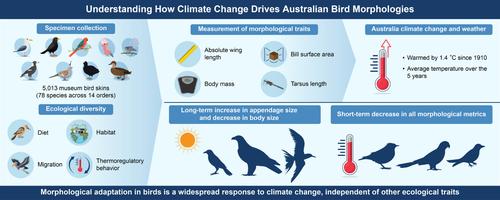当前位置:
X-MOL 学术
›
Glob. Change Biol.
›
论文详情
Our official English website, www.x-mol.net, welcomes your
feedback! (Note: you will need to create a separate account there.)
Long‐ and short‐term responses to climate change in body and appendage size of diverse Australian birds
Global Change Biology ( IF 10.8 ) Pub Date : 2024-10-18 , DOI: 10.1111/gcb.17517 Sara Ryding, Alexandra McQueen, Marcel Klaassen, Glenn J. Tattersall, Matthew R. E. Symonds
Global Change Biology ( IF 10.8 ) Pub Date : 2024-10-18 , DOI: 10.1111/gcb.17517 Sara Ryding, Alexandra McQueen, Marcel Klaassen, Glenn J. Tattersall, Matthew R. E. Symonds

|
Changes to body size and shape have been identified as potential adaptive responses to climate change, but the pervasiveness of these responses has been questioned. To address this, we measured body and appendage size from 5013 museum bird skins of 78 ecologically and evolutionary diverse Australian species. We found that morphological change is a shared response to climate change across birds. Birds increased relative bill surface area, tarsus length, and relative wing length through time, consistent with expectations of increasing appendage size as climates warm. Furthermore, birds decreased in absolute wing length, consistent with the expectation of decreasing body size in warmer climates. Interestingly, these trends were generally consistent across different diets and migratory and thermoregulatory behaviors. Shorter term responses to higher temperatures were contrary to long‐term effects for appendages, wherein relative appendage size decreased after hotter years, indicating the complex selective pressures acting on birds as temperatures rise with climate change. Overall, our findings support the notion that morphological adaptation is a widespread response to climate change in birds that is independent of other ecological traits.
中文翻译:

澳大利亚不同鸟类身体和附肢大小对气候变化的长期和短期响应
体型和体型的变化已被确定为对气候变化的潜在适应性反应,但这些反应的普遍性受到质疑。为了解决这个问题,我们测量了 78 个生态和进化上不同的澳大利亚物种的 5013 张博物馆鸟类皮肤的身体和附肢大小。我们发现形态变化是鸟类对气候变化的共同反应。随着时间的推移,鸟类增加了相对喙表面积、跗骨长度和相对翅膀长度,这与随着气候变暖而增加附肢大小的预期一致。此外,鸟类的绝对翅膀长度减少,这与在温暖气候下体型减小的预期一致。有趣的是,这些趋势在不同的饮食以及迁移和体温调节行为中通常是一致的。对较高温度的短期响应与对附肢的长期影响相反,其中相对附肢的大小在较热的年份后减小,这表明随着温度的升高,气候变化会作用于鸟类的复杂选择压力。总的来说,我们的研究结果支持这样一种观点,即形态适应是鸟类对气候变化的广泛反应,独立于其他生态特征。
更新日期:2024-10-18
中文翻译:

澳大利亚不同鸟类身体和附肢大小对气候变化的长期和短期响应
体型和体型的变化已被确定为对气候变化的潜在适应性反应,但这些反应的普遍性受到质疑。为了解决这个问题,我们测量了 78 个生态和进化上不同的澳大利亚物种的 5013 张博物馆鸟类皮肤的身体和附肢大小。我们发现形态变化是鸟类对气候变化的共同反应。随着时间的推移,鸟类增加了相对喙表面积、跗骨长度和相对翅膀长度,这与随着气候变暖而增加附肢大小的预期一致。此外,鸟类的绝对翅膀长度减少,这与在温暖气候下体型减小的预期一致。有趣的是,这些趋势在不同的饮食以及迁移和体温调节行为中通常是一致的。对较高温度的短期响应与对附肢的长期影响相反,其中相对附肢的大小在较热的年份后减小,这表明随着温度的升高,气候变化会作用于鸟类的复杂选择压力。总的来说,我们的研究结果支持这样一种观点,即形态适应是鸟类对气候变化的广泛反应,独立于其他生态特征。


















































 京公网安备 11010802027423号
京公网安备 11010802027423号